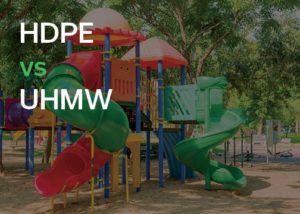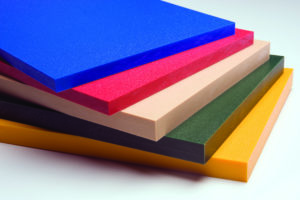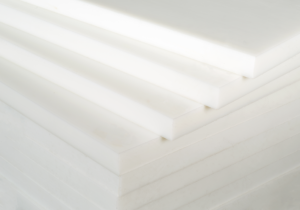
HDPE and UHMW are both known for their reliability across various industries and applications. There are many similarities between these two materials, leading some to believe they are interchangeable. However, each material has its own slightly different qualities that may make one better than the other for specific uses. Choosing the right material is critical for ensuring the most cost-effective, long-term solution.
To make sure that you choose the right plastic material for your exact needs, it’s important to know the pros and cons of each option that’s available to you. Both being ethylene monomers, HDPE and UHMW may seem very similar. Knowing how they differ can ensure that you are using the right material for your specific application.
What is HDPE?
HDPE (High-Density Polyethylene) is a Semi-Crystalline plastic material. It is known for its versatility and low moisture absorption. Its high-density chemical makeup results in low-absorbing properties, making it ideal for applications involving moisture or mild chemicals. This strong and cost-effective material is used for an array of applications, such plastic lumber and containers. Click here to learn more about HDPE sheets, their capabilities, and how Polymershapes can address your material needs.
Why Choose HDPE over UHMW
- Easier to machine and shape
- More cost-effective
- Less brittle
- High strength-to-density ratio
What is UHMW?
UHMW-PE (Ultra-High Molecular Weight Polyethylene) is a Semi-Crystalline Standard plastic material, and is often regarded as a “heavy duty” alternative to HDPE. It is known for its high abrasion and impact resistance. Its low-friction properties and high durability make it a cost-effective solution for many wear applications. Click here to learn more about UHMW brands and material options.
Why Choose UHMW over HDPE
- Stronger overall (better stiffness)
- Better for industrial applications (friction, rubbing, and other wear applications)
- Better temperature tolerances than HDPE
HDPE vs UHMW Properties
HDPE and UHMW are both thermoplastic polymers, meaning they share a few important properties. HDPE is usually the preferred material when cost is a factor, and UHMW is favored when performance is the main concern.
HDPE vs UHMW Friction
Both materials have a lower friction coefficient than many metals, such as stainless steel. HDPE has a coefficient of friction of around 0.2. Exact values tend to vary between manufacturer and grade, but UHMW is generally lower, with an average value of around 0.14. Some grades have an even lower value, meaning they require no lubrication dependency.
HDPE vs UHMW Hardness
Plastic hardness is a measure of a material’s resistance to indentation, deformation, scratching, etc. Both HDPE and UHMW are known for their strength and durability. UHMW’s long polymer chains and higher molecular weight allow it to sustain higher impacts and endure more trauma before it begins to wear. When hardness is less of a concern, HDPE is a lighter material that can still handle mild wear. HDPE features a notably high strength-to-density ratio despite its weight. HDPE cutting boards are a good example of its capabilities.
HDPE vs UHMW Wear Resistance
Both HDPE and UHMW feature high impact strength and chemical resistance. Both are very durable and can handle various demands across a wide range of applications. However, UHMW is better suited for applications involving mated parts, constant rubbing, heavy slamming, and more.
HDPE vs UHMW – Is One Better Than The Other?
HDPE and UHMW have many similar qualities, being that both are made of ethylene monomers. Choosing between them will depend on your specific needs and which material most effectively addresses those needs.
HDPE plastic is one of the most popular plastic materials. It is lighter than UHMW, which may be beneficial in applications looking to keep weight and costs low. It is generally easier to machine and less costly to produce than UHMW, making it one of the most common plastics. HDPE is often used for storage containers, tanks, and more.
UHMW is better suited for applications involving high-wear and heavy contact. It holds up much better than HDPE against friction and wear. For demanding applications with high-stress or harsh conditions, UHMW may be a more reliable option. UHMW is a cost-effective material often used as mated parts, wear parts, or even padding in machines.
Both materials are useful in a variety of instances. HDPE is often best used for items that need to be shaped using techniques like welding or 3D printing, especially in tanks or vessels that need to hold chemicals or other fluids. Meanwhile, UHMW tends to be better suited for industrial or manufacturing applications where friction or wear may be a concern.
What Applications Suit Each Plastic?
Choosing between UHMW and HDPE largely depends on the specific needs of the application. Both of these materials are known for being strong and durable, while also offering resistance to chemicals and abrasion. Furthermore, both versatile materials can be fabricated and machined. Making the decision between UHMW vs. HDPE involves choosing the option that’s the better fit for each specific use or industry.
HDPE Applications
HDPE’s strength, versatility, and resistance to water and chemicals makes it a very useful material. Its machining qualities allow it to be routed and shaped for various end uses. HDPE is often used to craft tanks or vessels that hold chemicals, water, or other fluids. From fuel tanks to piping, HDPE is a cost-effective material where sturdiness and moisture resistance is needed.
HDPE is notably used in outdoor/marine applications. Products like BOATBOARD® by SIMONA can be used in many features throughout a boat or ship, such as outdoor furniture, marine cabinets, instrument panels, doors and hatches, etc. SIMONA’s Polytone® is another product commonly used for outdoor signage and playground equipment.
UHMW Applications
UHMW is an especially popular choice for industrial applications that need to withstand constant friction. It has an extremely low coefficient of friction, meaning it does not wear as fast as other material alternatives. UHMW’s excellent wear properties make it a go-to replacement for metals.
UHMW products like TIVAR® by Mitsubishi Chemical Group are commonly found in manufacturing facilities, conveyor systems, machinery, and even food processing and packaging equipment. It is often used to fabricate components like wear strips, chain guides, bumpers, bearings, and guide rails.
UHMW plastic products can also be used in construction surfaces that operate under heavy loads and pressure, like outrigger pads. Like HDPE, it also provides resistance to water, so it can be used in impact-related marine applications, like dock fenders.
Browse Our Inventory of HDPE & UHMW
Polymershapes offers a wide array of HDPE and UHMW plastics made by the world’s most reputable manufacturers. Our inventory includes various grades and brands such as Proteus®, Boatboard®, TIVAR®, and many more. We provide a wide range of fabrication and machining services to shape, cut, or route materials to fit your needs.
To browse our full list of HDPE products or UHMW products, contact your local Polymershapes location today.

